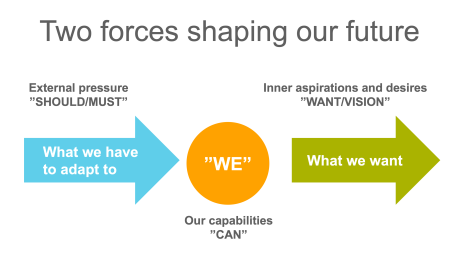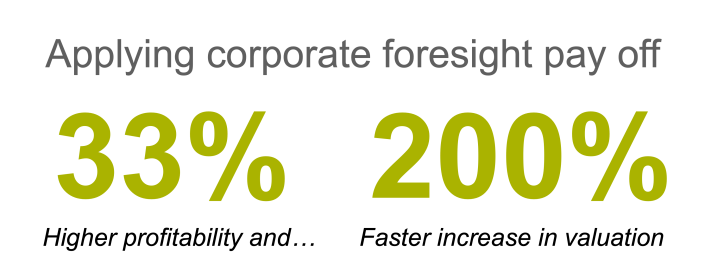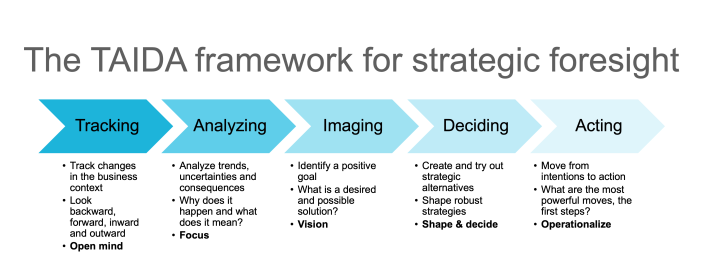Preparing for Uncertainty in a Highly Uncertain World: How to Utilize the TAIDA Strategic Foresight Framework for Long-Term Organizational Robustness
At Kairos Future, we talk about the two forces pushing and pulling us towards the future; the WANT and the SHOULD (or MUST) principles. We all, both as individuals and as organizations, have a vision of what we WANT – a compelling idea of what and where we want to be at some point in the future. But then there is the SHOULD, what we should or must take notice of and continuously monitor to keep being relevant, viable and robust in the future.
The SHOULD represents the continuous barrage of change that comes at us from the outside world as we move towards the future. Many organizations monitor developments in some sense, but to a lesser degree have a systematic and continuous approach to connecting the future to strategy. This is the first article in a three-part series about the TAIDA framework, a research-based methodology for achieving exactly that. Let´s dive in!

Two forces towards the future: Want and Should.
What does the future hold for your industry? As we edge further into a world shaped by rapid technological advancements, shifting consumer behaviors, and unforeseen challenges, the key question that leaders and decision-makers must ask is: How can we not only survive but thrive in the years ahead? The stakes are higher than ever, and the possibilities are vast for those who can navigate the turbulent waters of change. As we face the future, how can industries use strategic foresight, scenario planning, and AI-driven tools to stay ahead of the curve?
Many industries today are at a tipping point. Disruptive technologies, climate change, evolving global markets, and the AI revolution are all playing critical roles in how organizations need to approach strategy. The need to be future-focused has never been greater. With all the major challenges the world has been facing lately the focus has been mostly on the negative. But with these disruptions there are also opportunities – opportunities to innovate, create new market niches, and capitalize on trends.
To navigate this rapidly changing and complex environment, leaders must shift their mindset from reactive to proactive for their organizations to stay competitive, using tools to better prepare for the future. The traditional linear approach to planning is no longer sufficient; today’s strategy demands agility, vision, and actionable insight.
Dealing with Uncertainty
The developments of the last half-decade have made us viscerally feel the forces mentioned above. What most of us WANT is peace, a less polarized world, a more sustainable environment, a reduced threat of another pandemic, and perhaps a somewhat slower pace of change in general. But it is evident that the amount of change is not about to lessen, the SHOULD will most likely keep hunting us. Even before the developments of these last few years the changes driven by technology were enough to keep decision-makers at all levels up at night. The main villain is this: Uncertainty. How will the changes that are most central to your vision, your WANT, develop towards the future? How may you, as a leader and decision-maker, see the future where the strategic decision you need to make today will play out? What are the consequences forward of what we are seeing for our organizations?
The main villain is this: Uncertainty. How will the changes that are most central to our vision, our goals, develop towards the future?
Strategic Foresight Increases Profits and Growth
Research from the Aarhus School of Economics show that companies that are good at external monitoring – and actually work strategically with their insights – can increase their growth by 200 percent and profitability by 33 percent over a seven-year period. Spotting long-term trends in time and making business-critical decisions based on them is among the most important things you can do as a manager today – still only one in five companies are shown to have the type of continuous and systematic foresight practice that leads to these results. According to another recent survey, 20 percent of managers are highly stressed that they are not monitoring the world around them systematically enough.

Companies that are good at external monitoring can increase their growth in value by 200 percent and profitability by 33 percent over a seven-year period. (Source: Rohrbeck & Kum,2018).
The TAIDA Framework
The academic field of futures and foresight is a small, but expansive one. It is based on a number of methodologies and frameworks that can be seen as a toolbox for looking at the future. The internationally acclaimed TAIDA framework comprises five steps linking developments in the outside world to strategy development. TAIDA was developed by Dr. Mats Lindgren and has been the foundation of the research and projects at Kairos Future for over 30 years.
Even though many companies do have some manner of environmental scanning, for the work to positively affect the progress, profitability and growth of an organization, what we can see about the future needs to be connected to the strategy process. An effective way of working is to use a framework for strategic foresight, such as the TAIDA framework.
The TAIDA framework has been used for decades by organizations in strategic foresight and scenario planning to guide them in navigating uncertainty and preparing for the future. TAIDA stands for Tracking, Analyzing, Imaging, Deciding, and Acting – a cycle of processes that helps organizations anticipate the future and position themselves for success. Let’s break down each step:
- Tracking: The first step is to scan the horizon. In this phase, organizations observe trends, uncertainties, and internal capabilities. For your industry, this could mean analyzing trends in consumer behavior, advancements in automation, or emerging regulations that could impact operations.
- Analyzing: The intelligence gathered during the Tracking phase is examined closely to assess its impact and the consequences for your industry and your organization. Here, scenario planning comes into play, helping organizations visualize different plausible futures and assess their implications.
- Imaging: Once the organization understands the future landscape, it’s time to imagine a desirable future. What will your organization look like five, ten, or even twenty years from now? This step is about crafting a vision of what the organization can achieve in a rapidly changing world, and what assets and capabilities are needed for achieving this vision.
- Deciding: Next comes the critical decision-making process, where leaders develop strategies based on the insights and scenarios developed in the previous stages. What steps must be taken today to ensure success tomorrow?
- Acting: Finally, no strategy is complete without execution. This phase translates strategies into actions. What initiatives should be prioritized? Here, we also consider what is needed for creating change in the organization.
In the following articles in this series, we will look into the different steps of the TAIDA framework in more detail, starting with what to think about when tracking changes in the outside world, work that we at Kairos Future increasingly conduct with the assistance of AI-tools. AI is also one of the key trends that most organizations need to consider towards the future, along with trends and development specific to their industry.
The TAIDA framework. Click the figure for bigger size.
5 Key Trends That Will Shape Our Future
Comprising AI and automation, here are 5 trends that most organizations need to keep track of in the next decade:
- AI and Automation: The continued integration of AI and automation tools is not just enhancing productivity but reshaping entire business models. AI will likely become even more crucial in areas like forecasting, customer experience personalization, and operational efficiency.
- Sustainability and Green Technologies: As environmental regulations tighten and consumer awareness increases, industries must focus on sustainable practices. Green technologies are becoming a competitive edge rather than a niche innovation.
- Data-Driven Decision Making: Big data and analytics are evolving rapidly. Companies that can effectively harness and analyze large data sets will have the upper hand, gaining insights that drive better business decisions and improve outcomes.
- Changing Consumer Expectations: Digital transformation has raised the bar for customer expectations. Personalization, transparency, and speed are becoming standard requirements across industries, forcing organizations to rethink how they deliver value.
- The Remote and Hybrid Work Revolution: The shift toward flexible working environments will continue to evolve, requiring organizations to rethink their talent strategies, operational models, and technology infrastructure to remain competitive.
How the TAIDA Framework Can Help You Prepare for Uncertainty
The TAIDA framework is designed to give organizations a clear roadmap for navigating towards the future. Whether it’s through utilizing AI for analyzing trends, or a comprehensive scenario planning exercise, TAIDA enables organizations to take a proactive approach to future-proofing their strategy development.
By integrating the TAIDA framework into the strategy process, your organization may not only be prepared for the future but may be able to actively shape it. The future may be highly uncertain, but with the right tools and mindset, it can also present opportunities to innovate and grow.
Do You Want to Learn More about How to Create Foresight Capacity-Building in Your Organization?
Right now, we are accepting applications to the 2025 International Certified Future Strategist programme (ICFS), where we teach the toolbox of the TAIDA framework and develop participants into certified Future Strategists. As a Future Strategist, you can actively help your own organization, or client organizations, create preparedness for the future, and continued robustness towards the future.
Contact the ICFS Course Director Nina Al-Ghussein Norrman to get an invite to the next ICFS information session, or book an individual session. In case you speak Swedish, you can read about all our courses here.
Coming Articles in This Series:
Tracking – The Environmental Monitoring
Another recent study shows that as many as 93% of leaders and decision-makers that are tracking changes in the outside world in some manner experience positive effects of their environmental monitoring.
Automate Scanning with AI Tools
Not enough time is the main reason given by decision-makers that have not implemented continuous scanning of the environment. With the advent of Chat-GPT we can now be assisted in such work by different tools developed with the Open AI technology as a foundation. One such example is the AI-analytics platform Dcipher.

